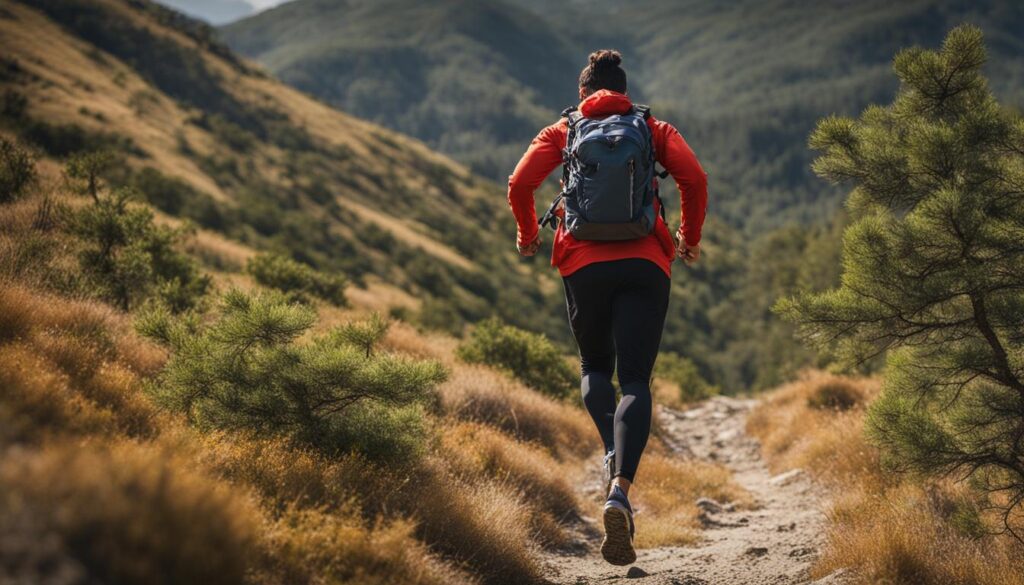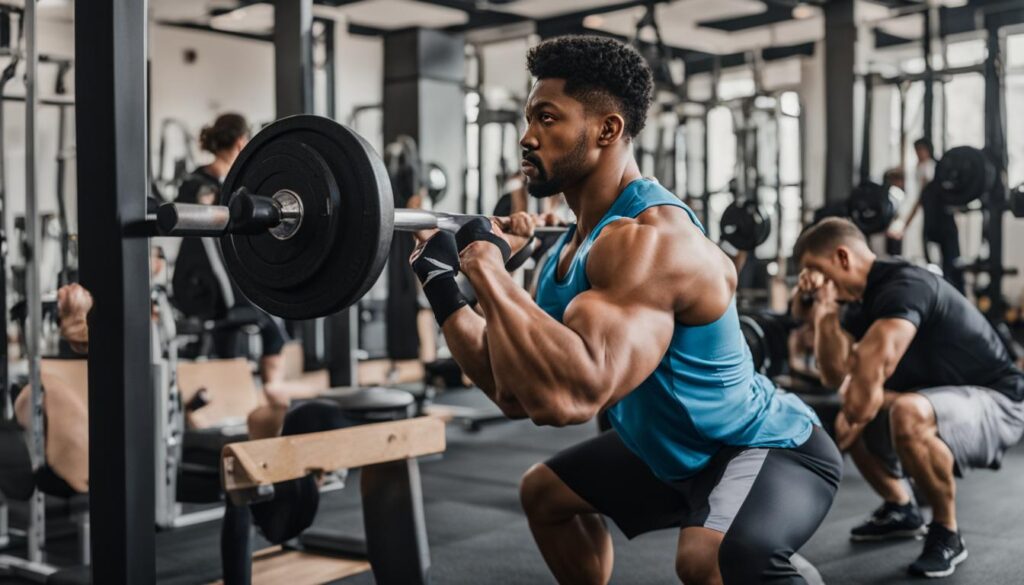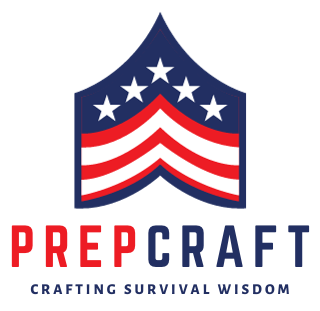
When it comes to survival, being physically fit is essential. But traditional gym workouts may not fully prepare you for the challenges you may face in the great outdoors. That’s where survivalist fitness comes in.
Survivalist fitness focuses on training for endurance and resilience, preparing your body for the unpredictable and demanding situations you may encounter. It goes beyond the typical exercises and incorporates movements that simulate real-life activities in unfamiliar and challenging conditions.
Laura Zerra, a seasoned survivalist with extensive experience in the backcountry, emphasizes the importance of training in random circumstances and unfamiliar conditions. By incorporating heavy and awkward object lifting, climbing, crawling, jumping, and high-intensity cardio into your workouts, you can build the endurance and resilience needed to survive in various situations.
Key Takeaways
- Survivalist fitness focuses on training for endurance and resilience in unpredictable outdoor environments.
- Incorporating heavy and awkward object lifting, climbing, crawling, jumping, and high-intensity cardio into workouts builds the necessary physical capabilities.
- Functional fitness mimics real-life activities and prepares individuals for the challenges they may face.
- Laura Zerra, a seasoned survivalist, advocates for training in random circumstances and unfamiliar conditions.
- Survivalist fitness is crucial for survival in various situations, providing individuals with the physical preparedness needed to thrive in demanding environments.
The Importance of Functional Fitness for Survival

Functional fitness is a key component of survivalist training, providing individuals with the necessary physical skills and capabilities to navigate both everyday life and emergency situations. Unlike traditional gym workouts that focus on isolated muscle groups, functional fitness emphasizes movements and exercises that mimic real-life activities, replicating the challenges individuals may encounter in survival scenarios.
By incorporating functional fitness into a training routine, individuals can develop the strength, endurance, and mobility required for survival. This type of fitness training engages multiple muscle groups simultaneously, improving overall physical readiness and reducing the risk of common injuries. Core strength, stability, balance, and flexibility are essential aspects of functional fitness, allowing individuals to perform tasks such as carrying heavy loads, climbing obstacles, and reacting quickly to dangerous situations.
Functional fitness also prepares individuals to react quickly and efficiently in high-stress environments, replicating the demands of emergency situations. By training in unpredictable and unfamiliar conditions, individuals can enhance their ability to make split-second decisions, adapt to changing circumstances, and overcome obstacles.
Incorporating functional fitness into a survivalist training regimen is crucial for developing the endurance, resilience, and survival fitness needed in challenging circumstances.
Functional fitness enhances physical readiness and reduces the risk of injury in survival situations.
“Survival fitness is not just about lifting weights or running on a treadmill. It’s about training your body to be prepared for any situation, whether it’s carrying heavy supplies or defending yourself in an emergency.”
Developing functional fitness is a comprehensive approach to survivalist training, focusing on the practical skills and capabilities needed to thrive in uncertain environments. By incorporating movements and exercises that mirror real-life activities, individuals can enhance their endurance, adaptability, and overall physical resilience.
Assessing Current Fitness Level for Survivalist Training

Before embarking on a survivalist fitness program, it is essential to evaluate your current physical condition. This evaluation should include an assessment of strength, cardiovascular endurance, flexibility, and any specific fitness weaknesses. Understanding your individual capabilities allows for a tailored approach to training that addresses your unique needs and optimizes your results.
Assessing your fitness level provides a baseline from which you can measure progress and set realistic goals. It also helps identify areas that require improvement, enabling you to focus on specific aspects of your training. The process of fitness assessment may involve various tests and measurements, such as:
- Strength assessment: Evaluating your strength by performing compound exercises like squats, deadlifts, and push-ups, or through specific strength tests targeting different muscle groups.
- Cardiovascular endurance assessment: Testing your cardiovascular fitness through activities like running, cycling, or completing a timed distance.
- Flexibility assessment: Assessing your range of motion and flexibility through exercises like the sit-and-reach test or yoga poses.
- Specific fitness weaknesses assessment: Identifying any areas where you may have weaknesses or limitations, such as joint mobility or balance issues.
By gathering this information, you can create a personalized fitness plan that addresses your strengths, weaknesses, and overarching goals. Remember that survivalist training requires a well-rounded approach, focusing not just on physical fitness but also mental resilience, practical skills, and adaptability.
Sample Fitness Assessment Table
| Assessment | Results | Comments |
|---|---|---|
| Strength | Upper body: 40 push-ups Lower body: 30 squats | Improvement needed in lower body strength |
| Cardiovascular Endurance | Completed a 5-mile run in 40 minutes | Above average cardiovascular endurance |
| Flexibility | Sit-and-reach test: 12 inches | Average flexibility |
| Specific Weaknesses | Balance and stability during single-leg movements | Focus on balance exercises |
Based on the assessment results, I can tailor my training plan to prioritize lower body strength exercises, incorporate balance and stability training, and maintain a consistent cardio routine to enhance my overall fitness and address specific weaknesses.
Key Components of a Survivalist Fitness Routine

A well-rounded survivalist fitness routine incorporates various components to build endurance, resilience, and prepare the body for challenging situations. By engaging multiple muscle groups simultaneously and focusing on functional exercises, cardiovascular conditioning, strength training, and outdoor and wilderness training, individuals can enhance their physical capabilities and maneuverability in rough environments.
Functional Exercises for Dynamic Movements
Functional exercises play a crucial role in survivalist fitness routines as they mimic real-life movements and prepare the body for the dynamic challenges individuals may encounter. Incorporating exercises like burpees, kettlebell swings, and mountain climbers engages multiple muscle groups and improves overall coordination and agility.
Cardiovascular Conditioning for Stamina
To build endurance and improve aerobic capacity, cardiovascular conditioning exercises are essential. Activities such as running, high-intensity interval training, and jump rope workouts enhance stamina and cardiovascular fitness. These exercises simulate the demands of survival situations, where individuals may need to cover long distances or engage in prolonged physical exertion.
Strength Training for Functional Strength
Survivalist fitness routines include strength training exercises to build functional strength necessary for carrying supplies and performing essential tasks. Bodyweight exercises like push-ups, pull-ups, and squats, along with resistance training using resistance bands or dumbbells, help develop muscular strength and endurance.
Outdoor and Wilderness Training for Adaptability
Survivalist training wouldn’t be complete without outdoor and wilderness training. Training in unfamiliar terrain and challenging outdoor environments improves adaptability and tests individuals’ abilities to handle various scenarios. This training may involve hiking, orienteering, and practicing survival skills like building shelters or starting fires.
Flexibility and Mobility Exercises for Maneuverability
Flexibility and mobility exercises are crucial for surviving in rough environments where maneuverability is essential. Incorporating exercises like yoga, stretching routines, and mobility drills helps improve joint mobility, range of motion, and overall flexibility. This allows individuals to navigate obstacles, perform tasks requiring agility, and minimize the risk of injuries.
By incorporating these key components into a survivalist fitness routine, individuals can develop the physical attributes necessary for enduring challenging situations. The combination of functional exercises, cardiovascular conditioning, strength training, outdoor and wilderness training, and flexibility exercises ensures holistic preparation for survivalist training.
The Importance of Mental Resilience in Survivalist Fitness
Mental resilience is a crucial aspect of survivalist training that should not be underestimated. In high-stress situations, maintaining a calm and focused mindset is essential for making sound decisions and effectively navigating challenges. Alongside physical abilities, incorporating practices that foster mental resilience is key to preparing for emergencies.
One beneficial practice is meditation, which helps individuals develop mental clarity, improve concentration, and reduce stress levels. Taking a few minutes each day to sit in quiet reflection can provide clarity and enhance mental fortitude. Deep breathing exercises are another effective technique for managing stress and increasing resilience. By focusing on slow, deliberate breaths, individuals can activate the body’s relaxation response and restore a sense of calmness in difficult situations.
“The mind is a powerful tool in survival situations. Training it through mindfulness and meditation practices allows one to remain calm, think clearly, and adapt to changing circumstances effectively.” – Laura Zerra, survivalist expert.
Mindfulness, the practice of staying fully present in the current moment, is also beneficial for fostering mental resilience. By being aware of one’s surroundings and thoughts, individuals can remain focused and responsive, making better decisions under pressure. Incorporating mindfulness exercises into daily routines can help cultivate a resilient mindset that carries over into survivalist training.
Techniques for Building Mental Resilience:
- Practice daily meditation sessions to improve focus and self-awareness.
- Engage in deep breathing exercises to manage stress and promote calmness.
- Cultivate a mindfulness practice to stay present and focused in high-pressure situations.
By combining physical fitness with mental resilience training, individuals can be better prepared to handle the physical and psychological demands of survivalist scenarios.
| Mental Resilience Techniques | Description |
|---|---|
| Meditation | A practice that involves focusing the mind and eliminating negative thoughts and distractions, enhancing mental clarity and calmness. |
| Deep Breathing Exercises | Techniques that involve purposeful, controlled breathing to reduce stress, activate the body’s relaxation response, and promote a sense of calmness. |
| Mindfulness | A state of being fully present in the current moment, allowing individuals to stay focused, make better decisions, and adapt to changing circumstances. |
The Role of Nutrition and Hydration in Survivalist Fitness
Proper nutrition and hydration are vital components of survivalist fitness. In order to maintain energy levels and overall well-being, it is crucial to prioritize a well-balanced diet and adequate hydration.
A well-balanced diet should consist of nutrient-dense foods. Including a variety of fruits, vegetables, lean proteins, whole grains, and healthy fats ensures that individuals have the necessary fuel to meet the physical demands of survivalist training. Nutrient-dense foods provide essential vitamins, minerals, and antioxidants that support overall health and optimize performance.
Hydration is especially critical in survivalist fitness, particularly during times when water resources may be scarce. Staying properly hydrated helps regulate body temperature, supports digestion, and aids in the transportation of nutrients. It is recommended to have a reliable water filtration system, such as a life straw, as part of a bug out bag or survival kit to ensure access to clean drinking water in emergency situations.
“Water is essential for survival, and proper hydration is key to maintaining peak performance, both mentally and physically.” – Laura Zerra
By prioritizing nutrition and hydration, individuals can optimize their physical and cognitive abilities during survivalist training. Adequate fuel and hydration contribute to improved endurance, strength, and mental acuity, enhancing overall performance and resilience in challenging situations.
| Benefits of Proper Nutrition in Survivalist Fitness | Benefits of Hydration in Survivalist Fitness |
|---|---|
| 1. Fuel for physical demands | 1. Regulation of body temperature |
| 2. Essential nutrients and antioxidants for overall health | 2. Support for digestion and nutrient transport |
| 3. Enhanced endurance and stamina | 3. Maintenance of cognitive function |
| 4. Efficient recovery and reduced risk of injury | 4. Prevention of dehydration-related complications |
Survivalist fitness is a holistic approach that encompasses physical fitness, mental resilience, and practical skills. Prioritizing nutrition and hydration ensures that individuals are well-equipped to face the physical and mental challenges of emergency situations with strength, endurance, and clarity of mind.
Conclusion
Survivalist fitness is a comprehensive approach that goes beyond physical strength, encompassing mental preparedness, practical skills, and adaptability. By integrating functional exercises, cardiovascular training, strength exercises, flexibility workouts, wilderness survival training, and mental resilience practices, individuals can be better prepared for any emergency.
Being physically fit for a crisis is not just about survival; it empowers individuals to protect themselves and their families, significantly increasing their chances of success in challenging circumstances. With survivalist fitness, you can enhance your endurance, strength, and agility, enabling you to navigate and overcome obstacles effectively.
Preparation for emergencies requires a holistic approach that includes both physical and mental readiness. It is essential to build your fitness foundation, develop practical skills, and cultivate mental resilience. By incorporating survivalist fitness into your life, you can be better equipped to face unexpected situations with confidence and determination.
FAQ
What is survivalist fitness?
Survivalist fitness is a training approach that focuses on building endurance and resilience for real-life activities and unpredictable outdoor environments.
Why is functional fitness important for survival?
Functional fitness prepares the body for the challenges individuals may face in emergencies or difficult situations by mimicking real-life movements and activities.
How do I assess my current fitness level for survivalist training?
It is essential to evaluate your strength, cardiovascular endurance, flexibility, and identify any specific fitness weaknesses before starting a survivalist fitness program.
What are the key components of a survivalist fitness routine?
A well-rounded routine should include full-body workouts, cardiovascular conditioning, strength training, outdoor and wilderness training, flexibility, and mobility exercises.
Why is mental resilience important in survivalist fitness?
Mental resilience techniques, such as meditation and mindfulness, help individuals stay focused and calm during high-stress situations, improving decision-making and the ability to navigate challenges effectively.
How does nutrition and hydration play a role in survivalist fitness?
Proper nutrition with nutrient-dense foods and adequate hydration is essential for maintaining energy levels and overall well-being during survivalist fitness training.
How does survivalist fitness prepare individuals for emergencies?
Survivalist fitness enhances physical and mental preparedness, practical skills, and adaptability, equipping individuals to better handle emergency situations and protect themselves and their families.


